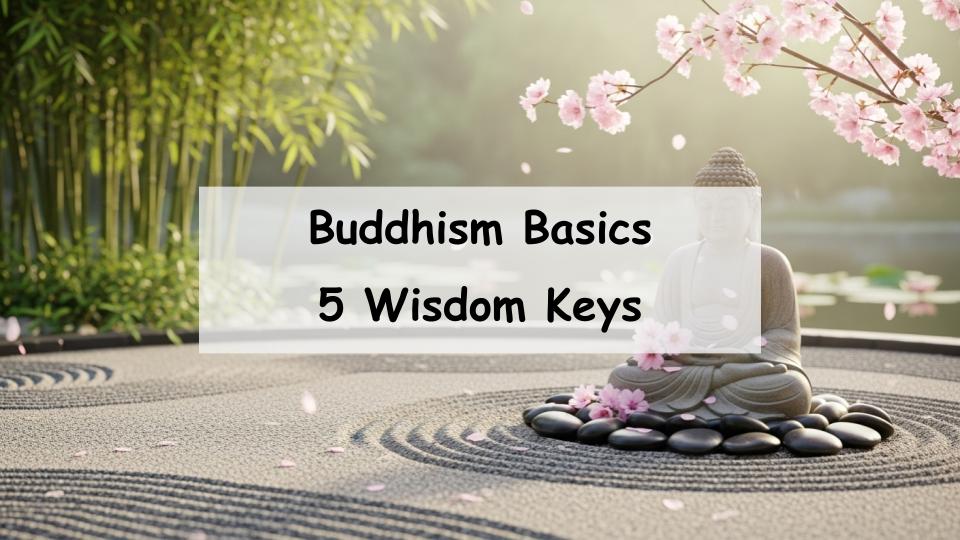Are you interested in the teachings of Buddhism but feel overwhelmed by unfamiliar terms or complex concepts?
Even in today’s fast-paced society, Buddhist teachings offer timeless wisdom that can gently address our worries and emotional struggles.
This article is designed for beginners who want to understand Buddhist teachings in a simple and approachable way.
We’ll explain five essential points that summarize the core ideas of Buddhism in an easy-to-digest format.
Whether you’re wondering, “What is Buddhism?” or “How can I apply these teachings to my daily life?”, you’ll find clear and practical answers here—without needing a religious background. If you’re curious about Buddhism, this is a great place to start.
- What Are the Teachings of Buddhism? A Beginner-Friendly Overview
- 5 Key Points to Understand the Teachings of Buddhism
- Point 1: What Is the Concept of “Four Noble Sufferings”?
- Point 2: Learning a Right Way of Living through the Eightfold Path
- Point 3: Cause and Effect – The Concept of Karma
- Point 4: The Impermanence of Life and the Importance of Living in the Present
- Point 5: The Power of Compassion in Harmonizing Human Relationships
- Applying Buddhist Teachings to Everyday Life
- How Beginners Can Start Learning the Teachings of Buddhism
- Conclusion: Buddhist Teachings Are Simple Yet Deep
- A Message from the Guide
What Are the Teachings of Buddhism? A Beginner-Friendly Overview
The Origins of Buddhism and the Life of the Buddha
The teachings of Buddhism originated over 2,500 years ago in ancient India, with a man known as the Buddha (Siddhartha Gautama). Born into royalty, he lived a life of luxury until he encountered the realities of aging, illness, and death. These experiences led him to question the nature of suffering. Leaving behind his privileged life, he embarked on a spiritual journey and ultimately attained enlightenment. His teachings on how to overcome suffering laid the foundation of Buddhism.
Suffering and Liberation: Core Concepts in Buddhism
At the heart of Buddhism is the understanding that life involves suffering. But rather than being pessimistic, this insight leads to hope: suffering has a cause, and therefore, it can be overcome. This idea is structured around the “Four Noble Truths,” which outline the reality of suffering, its origin, its cessation, and the path to freedom. These teachings help us face life’s hardships with clarity and resilience.
The Inner Transformation Buddhism Aims For
Unlike belief systems that focus on changing external circumstances, Buddhism emphasizes internal transformation. The goal is to free oneself from desires, anger, and attachments to achieve a calm and stable mind. This state of mind is not abstract—it’s something that can be developed through daily practice and reflection, offering practical guidance for modern life.
5 Key Points to Understand the Teachings of Buddhism
Point 1: What Is the Concept of “Four Noble Sufferings”?
One of the most well-known teachings in Buddhism is the concept of the “Four Noble Sufferings” (and the extended “Eight Sufferings”). These include birth, aging, illness, and death. They also cover emotional pains such as separation from loved ones, association with the unpleasant, not getting what one desires, and the suffering that arises from our physical and mental form. Understanding that suffering is a shared human experience helps us realize we’re not alone in our struggles.
Point 2: Learning a Right Way of Living through the Eightfold Path
The “Eightfold Path” provides practical guidance for living in a way that leads to peace and freedom. It includes elements like right view, right intention, right speech, and right action. These teachings help us reflect on our behavior and mindset, offering a structured path toward a more mindful and compassionate life.
Point 3: Cause and Effect – The Concept of Karma
Buddhism teaches that every action has consequences—a principle known as karma. Good actions bring positive outcomes, while harmful actions bring suffering. This cause-and-effect relationship encourages us to live responsibly and mindfully, knowing that our choices shape our present and future.
Point 4: The Impermanence of Life and the Importance of Living in the Present
Impermanence is a central theme in Buddhism. Everything changes—nothing remains the same. This insight helps us let go of attachments and accept change, whether it’s the end of a relationship or the passing of time. It encourages us to live fully in the present moment, rather than clinging to what was or fearing what may come.
Point 5: The Power of Compassion in Harmonizing Human Relationships
In Buddhism, compassion means more than just being kind. It involves deeply understanding others’ suffering and actively working to relieve it. Practicing compassion transforms how we interact with others, reduces conflict, and builds more peaceful relationships in all areas of life.
Applying Buddhist Teachings to Everyday Life
How Mindfulness, Rooted in Buddhism, Helps Modern People
Mindfulness, now widely practiced around the world, has its roots in Buddhist meditation. Focusing your attention on the present moment helps reduce stress and anxiety, and builds emotional clarity. Simple breathing techniques or moments of silence are powerful ways to reconnect with yourself amid a busy lifestyle.
Resolving Relationship Issues with Buddhist Wisdom
Relationship challenges often arise from expectations and attachments. Buddhism teaches that instead of trying to control others, we should reflect on our own reactions and emotions. By focusing on self-awareness and inner calm, we can build healthier, more understanding relationships.
Managing Stress and Anxiety with a Buddhist Mindset
Much of our stress stems from regrets about the past or worries about the future. Buddhism invites us to let go of these attachments and embrace the “now.” By developing a sense of equanimity and perspective, we reduce emotional turmoil and restore a sense of balance.
How Beginners Can Start Learning the Teachings of Buddhism
Start with Accessible Books or Modern Translations, Not Ancient Texts
Buddhist scriptures can be overwhelming at first. Beginners are encouraged to start with modern translations or introductory books that explain key teachings in plain language. Audio lectures, videos, and other media can also make learning easier and more enjoyable.
Three Important Mindsets for Learning Accurately
To understand Buddhism properly, it’s important to approach it with a questioning attitude, rely on personal experience, and stay committed to learning over time. Buddhism doesn’t demand blind belief; instead, it encourages exploration and practice that leads to real-life insight.
Be Cautious of Online Misinformation and Choose Reliable Sources
While the internet offers a wealth of information, not all of it is accurate or balanced. Stick to credible sources such as Buddhist organizations, scholars, temples, and trusted publications. Free online courses or community lectures can also be great starting points.
Conclusion: Buddhist Teachings Are Simple Yet Deep
Incorporate Simple Teachings into Daily Life Right Away
Buddhism offers many teachings that are simple and immediately applicable. Being kind to others, letting go of small frustrations, and living in the present are all practical steps you can start today. These small shifts in mindset can bring significant positive change over time.
The Deeper You Go, the More You Gain from Continued Learning
Buddhist learning is a lifelong journey. As you revisit the teachings and apply them to new experiences, your understanding will deepen. Over time, you’ll notice a calmer mind, more balanced emotions, and more meaningful relationships. Take your time, be consistent, and let the teachings of Buddhism naturally enrich your life.
A Message from the Guide

Fully understanding and practicing the teachings of Buddhism is not easy.
When you visit a temple, even just briefly reflecting on the teachings of Buddhism can help you have a more meaningful experience.







Comment